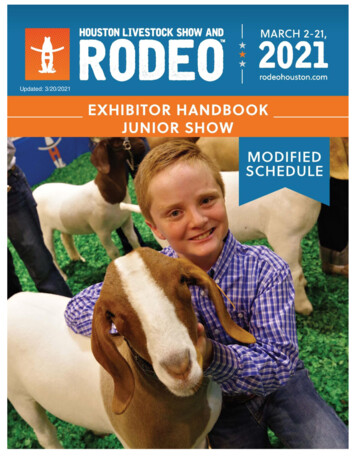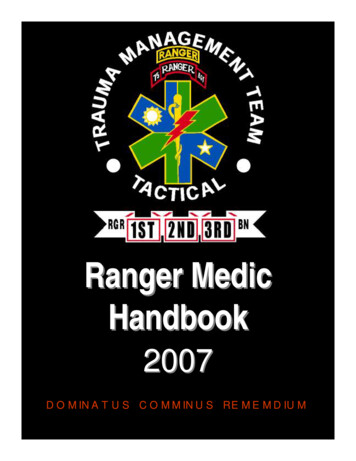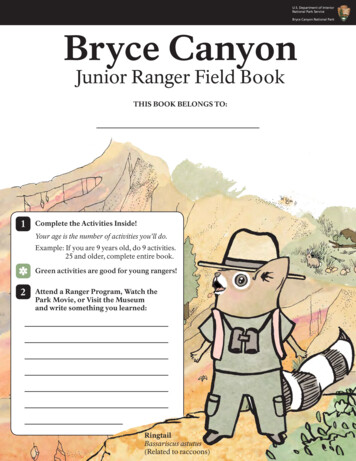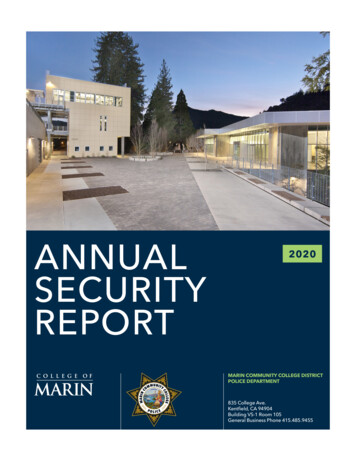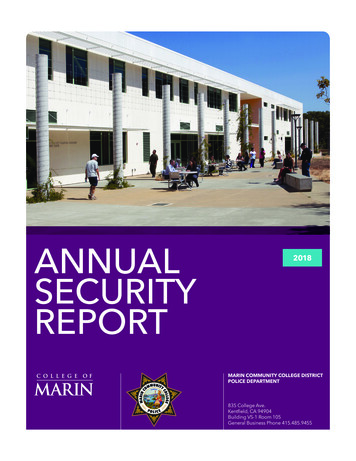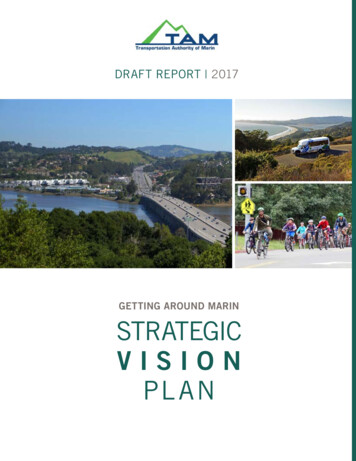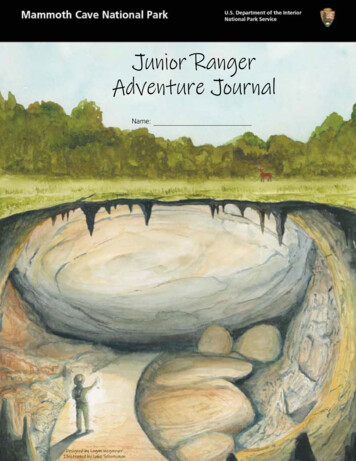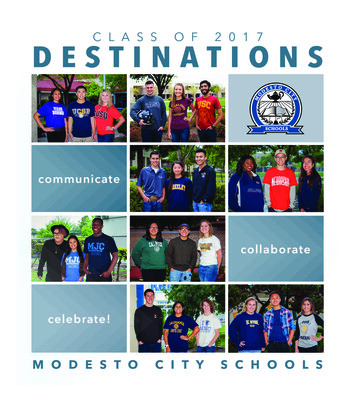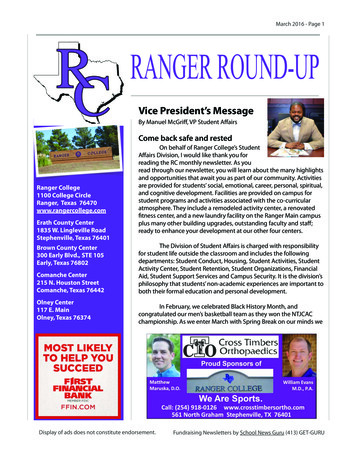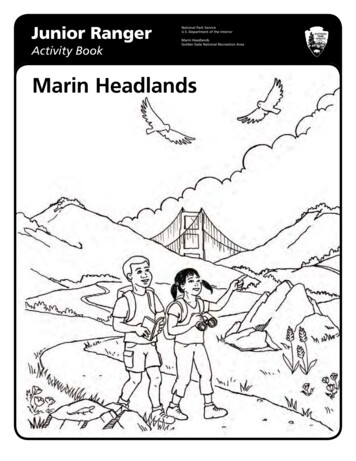
Transcription
Junior RangerActivity BookNational Park ServiceU.S. Department of the InteriorMarin HeadlandsGolden Gate National Recreation AreaMarin Headlands
Getting StartedSo you want to be a Junior Ranger? Welcome. Your National Parks need you!If you are.then you should.6–8 years oldLook for pages with a duck in the cornerChoose 4 pages & complete them9–10 years oldChoose 8 pages & complete them11–12 years oldComplete the entire bookletand try to answer the Challenge Questionsmarked with a heronThe map below will help you find your way around. Pages 4 through 10 need to be completed atspecific places (look for the location at the top of the page). The other pages can be completedwherever you like in the Marin Headlands.Orient Yourself!North, south, east, west—do you know which direction you’re facing? While you’re in the MarinHeadlands (or anywhere on the coast of California) turn toward the ocean. This is west. If theocean is at your back, you’re facing east. If you can see San Francisco from the Headlands, you’refacing south. The sun can also help you orient yourself; it rises in the east, it sets in the west. Atnight, the stars will show you the way. Google “monthly star charts” and print out a star chart;learn just a few constellations and you can orient yourself anywhere.RoadsParkingHawk Hill /Construction129RodeoBeachPoint BonitaLightouseTrailsVisitor CenterBatterySpencerNo rthTo San FranciscogeGolden Gate BridMilitary Site
Scavenger Hunt BINGOAs Junior Rangers, we always watch the world around us. On your journey through the Marin Headlandstoday watch for these things. Put an “X” on the picture when you find them. See if you can find them all!Dragon FlyFogFresh WaterCypress TreeChertHarbor SealsLookoutPelicansSalt WaterShipSpider WebPoison OakSunTurkey VulturesDraw your own.DeerBobcatBasaltButterflyWildflowersWhat didn’t you see today? Why do you think you didn’t?
STOP: Marin Headlands Visitor CenterExplore the Marin Headlands Visitor CenterThe place we now call the Marin Headlands has been home to many people over the years. Each groupused the land differently. The exhibits in the Visitor Center will help you complete this activity.Who lived in this area? Pick up a trash bag and glove while at thevisitor center so you can help out inthe park. Be sure to follow safetyinstructions.Draw lines to match the group of people to theobjects they used.
Sense Your Way AroundSTOP: Includes Visitor CenterWhen you explore a new place, you get a lot of information from your senses. Using your sensesadds to your fun.Your Eyes Tell TimeWalk out of the Visitor Center to the lagoon trail. Stand at the trailhead sign. This old picture ofFort Barry helps you look back in time. Using your eagle eyes, find three things that are the sameand three that are different.What is the same?What is different?All the Better to Smell You With!Coyotes have a great sense of smell. Their noses are big andmoist, and they search for scents by moving their heads. Dampenyour nose with water and turn your head slowly from side to side.What do you smell?Make Deer Ears!Mule deer hear really well with their big ears. Sit quietly, close your eyes for one minute, and listen.Then cup your hands behind your ears. Can you hear better?List all the natural sounds you hear.(Made by an animal, plant, or otherthings in nature)List all the human sounds you hear.(Made by machines or people)
The Ocean Needs Your HelpMany living things (including people) depend onthe ocean for food. Yet today, the ocean and thecreatures that live in it are being hurt by something we use every day: plastic. Plastic is mademostly of oil, so it never biodegrades (breaksdown and becomes part of the soil or water).Almost all the plastic on earth today will stillbe here a thousand years from now.Many birds and marine animals eat plankton,tiny ocean-living animals and plants that drifton the currents. Some are so small that thousands could fit in the period at the end of thissentence. Plastic rubbish that finds its way tothe ocean looks a lot like food to hungry marineanimals—bottle caps, foam cups, and plastic bagshave all been found in the stomachs of sea lions,dolphins, sea turtles, and birds. Tiny pieces ofplastic mimic (look like) plankton but hurt thecreatures who eat them.The trash you pick up today won’t go into theocean, and that helps whales, fish, and pelicans.And when the ocean is healthier, so are we!What else could you do?You can help reduce the amount of plastic inthe ocean. Use paper instead of plastic disposable items. Share what you have learned with others.Count the plastic and plankton in the ocean below.Plastics:Plankton: 1000 pounds of plastic 1000 pounds of planktonWhat is the ratio of plastic to plankton in the ocean?*Ratios describe relationships. If a classroom has one teacher and thirty students, the teacher/student ratio is 1:30.
STOP: Rodeo BeachOn the Beach.Every wave that crashes onto a beach is different. Some are small, some are huge, some bringsand and trash onto the beach, and some take them away. And waves never stop coming!Have someone time you as you count the number of waves that crash onto the beach in one minute.How many waves did you count?Walk along the beach. Draw something you see.Rainbow SandTake a handful of sand. Put it on this page. (Slightly damp sand is the easiest to sort. Try a fewhandfuls until you find grains that are big enough to see easily). Now sort the sand by color.What colors do you see in the sand?Look at the hills around you.Can you see any of the same colors?How do you think these pieces got here?How did they get so small?Sometimes rocks on a beach come from faraway mountains. Since Rodeo Beach is located ina crescent shaped cove, (shown right) we knowthat these rocksrw came from nearby cliffs.Multiply the number of waves per minute by minutes in an hour (60), and then multiply theresult by the number of hours in a day (24). About how many waves crash on Rodeo Beach in one24-hour day?NEXT STOP: As you leave Rodeo Beach, head toward Battery Spencer and the main viewpoint forthe Golden Gate Bridge.
STOP: Battery SpencerGuarding the GateThe U.S. Army occupied the Marin Headlands (andmuch of what is now Golden Gate NationalRecreation Area) for nearly 125 years.Over the years, the army constructed several defensiveposts, waiting for attacksthat never came.Battery Spencer,was built in 1897on what wasconsideredthe “most strategically importantspot” from which to guard theentrance to the San FranciscoBay. The battery’s big guns couldfire their shells 10 miles.As you walk through the area, chart your path on the illustration above.Mark the places where you see the following, or guess where they would go:L (lookouts), G (places for guns), F (fireplace), Q (living quarters), S (switchboard).If you were in the Army and worked at this spot, what kind of job do you think you would want to have?Battery Spencer, Fort Baker((/3" 1BSL "SDIJWFT 17206Why do you think the entrance to the Golden Gate was such an important place to guard?NEXT STOP: Look to the Northwest, up on the hill. (Remember your orientation clues from page2). There is another battery, Construction 129, or Hawk Hill. Go there next.
STOP: Hawk Hill / Construction 129A Place with Two Names.Every fall, thousands of hawks and other raptors (birds of prey) fly over this very spot on theirway to their winter homes. As these birds make their journey, they orient themselves using theocean and the sun. Raptors use thermals (patches of warm air rising up from the land) to maketheir long flights less tiring. In this spot, the break in the coastline (the entrance to the bay) funnels them right over our heads! If you are here in the fall, LOOK UP!!!!!KestrelRed Trail HawkCooper’s HawkTurkey VultureThe Army gun battery inside the hill is called Construction 129. Work started on this batteryduring World War II (1941 to 1945), but it was never finished. What do you think? Was the moneywasted? Is it possible that no enemy attacked because the forts and gun batteries were here?Walk around. Make a list of all the ways Construction 129 is different from Battery Spencer. (Doesit look different? Does it feel different to beinside? Do you think it is stronger or weaker?)Walk through the western tunnel (remember to orient yourself using the ocean). From here, you cansee the lighthouse. How many seconds does the light stay on?How many seconds is itoff?This is called the lighthouse’s signature; every lighthouse has its own signature.The guns here could shoot shells 25 miles out to sea. Why did the Army move guns fartheraway from the entrance to the Bay?NEXT STOP: Head to the Point Bonita Lighthouse trail.
STOP: Point Bonita Lighthouse TrailBeacons to the PastThe lighthouse is only open on Saturday, Sunday, and Monday from 12:30 to 3:30. But even if youcome when the lighthouse is closed, you will still find cool things to explore. (To take another peek atthe lighthouse, go to the end of the road—west, toward the ocean—and look from the parking lot).Whileyou’re here:Count theships yousee.“City of New York” in San FranciscoGGNRA, Park Archives SH- 060Before gold was found in California, not many ships came this way. But in 1849, when the GoldRush started, 775 ships entered San Francisco Bay, Today, almost 5,000 big cargo ships enterthe harbor annually.The number of shipwrecks grew too. Look at the Golden Gate and think about what makes it a hardplace to sail a ship through.Why do you think there were a lot of shipwrecks? (Think of waves, size of the channel, weather.)In 1855, the lighthouse was built on a nearbyhilltop; it was later moved to its present location.The lighthouse keepers had to stay here all thetime to put oil in the lamp, trim the wick, cleanthe crystal lens and the window around it. Backin the 1850s, there was no big city, or bridge,or soldiers. The people who lived here were farfrom everything and everyone.The keepers brought their families with them.If you lived here with your family 100 years ago,what would you do for fun?Watch for harbor sealslying on the rocks in thecove to the east.NEXT STOP: The next three activity pages can be completed on any trail or open space in theMarin Headlands.
STOP: Any trail in the parkWho Lived Here First?Native plants are plants that have always lived in a place. Non-native plants are those that havebeen introduced to an area, usually by human activity. For example, most of the grass in the MarinHeadlands was “planted” by seeds falling off the hooves and hides of cattle brought here byranchers more than 150 years ago. Likewise, most of the trees you see here were planted by theArmy and lighthouse keepers about 100 years ago, to serve as windbreaks and landscaping; overtime, the trees’ seeds spread and more trees grew.Native Plant SYXBlackberryCobweb thistleYerba buenaSoap plantLupineWillowCow parsnipPoppyCoyote brushYarrowPoison oakWhen only the Coast Miwok people lived here a thousand years ago, this was their grocery store,hardware store, and drugstore. Guess which word-search plants were used to make:You can find out about native plants near your home by going to parks, museums, yourlocal native plant society or State Department of Natural Resources.Do you think it matters if new and different (non-native) plants start to live here?Why or why not?
STOP: AnywhereScat and TracksWhat’s that?!!!! EEEWWWWWWWW“Scat” is what we call animal poop. Have you ever thought of what you could learn from studyingscat? As you spend your day here, look for some dry scat. (Once it’s dry, it isn’t smelly anymore).If you find some scat, break it up with a stick or a rock.What do you think the animal ate? An omnivore eats plants and animals. An herbivore eats only plants. A carnivore eats only animals.What kind of eater was the animal?What kind of eater are you?Why do you think it is important to pick up a pet dog’s scat in wild places? Why do you thinkthe scat of wild animals is important?In the past, people used to hunt animals by following their scat and tracks.Rangers still do this, but now, they’re hunting facts: what kind of animalslive here, how many of them are there, what are their habits?Draw lines to match each animal to its track and scat.
STOP: AnywhereThe Gift of Open SpaceWhen the U.S. Army realized they no longer needed this land to defend the Golden Gate, they gaveit to the National Park Service and it became part of Golden Gate National Recreation Area. Thisgift of open space is vital to the animals who live here, many of whom need open space to stay healthy.Today, when we visit the Marin Headlands, we can look at the city of San Francisco and imagine what itmay have looked like before the Gold Rush and before it was full of people and buildings and cars.Facing the city, write a few words about what you see:How does it make you feel?Now, turn your back to the city and scan the Marin Headlands. Write a few words about what you see:How does it make you feel?Now write your poem .Anyone can write a poemSome people follow rules, and others justwrite what they see and feel. Can you takeyour words and thoughts and make them intoa poem? For example.sdnApn your neighkiboaroorhdMarin HeadlaBustling trafficYou make me want to go fast.Rolling hillsI love to see your colorsAnd the ocean beyond you.How is the Marin Headlandsthe same as a park in yourneighborhood?Write your ideas in the spacewhere the circles overlap. Inthe outer circles, write theways they are different.
It’s a Junior Ranger’s Job.Because the Marin Headlands is so close to a big city, lots of people visit here, sometimesthousands every day.Just as we wouldn’t want someone to come into our house and take our things or walk on ourfurniture, when we’re in a national park, we stay on trails and leave what we find. Everythingin the park’s ecosystem is connected in a web.Help protect the Marin Headlands. Circle things you are encouraged to do while you visit. Putan X on things that could hurt the park.Choose one of the ways we ask people to help protect the park and explain why it is important.More ways to enjoy, explore, and help the parks. Camp out overnight (Just reserve a campsite in advance). Ride a bicycle or take the bus. Pack your lunch in a reusable container. (Can you make a lunch with no waste?) Go to theVisitor Center for a bird or wildflower checklist. Ask about ranger programs or volunteeropportunities for young people. Keep a journal or scrapbook to record what you see, feel,and enjoy during your visit!
Getting Your BadgeWhen you have completed the booklet, you can bring it back tothe Visitor Center and have someone check it right there. If youare on your way out, you can mail the booklet to us and we’llsend you your badge! Marin Headlands Visitor Center Bldg.948, 'PSU #BSSZ 4BVTBMJUP " Exploring your Bay Area National Parks & MonumentsJohn MuirNHSRosie theRiveter NHPEugeneO’NeillNHSGolden GateNational Recreation Area(415) 561-4720www.nps.gov/gogaSan Francisco MaritimeNational Historic Park(415) 447-5000www.nps.gov/safrJohn MuirNational Historic Site(925) 228-8860www.nps.gov/jomuMuir WoodsNational Monument(415) 388-2596www.nps.gov/muwoFort PointNational Historic Site(415) 556-1693www.nps.gov/fopoEugene O’NeillNational Historic Site(925) 838-0249www.nps.gov/euonPoint ReyesNational Seashore(415) 464-5137www.nps.gov/poreRosie the RiveterNational Historic Park(510) 232-5050www.nps.gov/roriAll illustrations by Melissa WestWritten by Suzanne Pegas
JUNIORRANGERSThis certifies thatMarin HeadlandsDateOfficial Park Stamphas completed all activities, and is granted the title of Junior Ranger for taking on active interest in theJunior Ranger PledgePark Official SignatureAs a Junior Ranger, I promise to explore, learn about and helpprotect the Marin Headlands and all National Parks. Protectingthe parks means I will share what I have learned with others and“leave no trace” by staying on trails and picking up trash. By recycling, reusing and reducing I pledge to be a friend to all NationalParks and to the planet earth.Junior Ranger Signature
Walk along the beach. Draw something you see. Rainbow Sand . Take a handful of sand. Put it on this page. (Slightly damp sand is the easiest to sort. Try a few handfuls until you find grains that are big enough to see easily). Now sort the sand by color. What colors do you see in the sand? Look at the hills around you. Can you see any of the .
